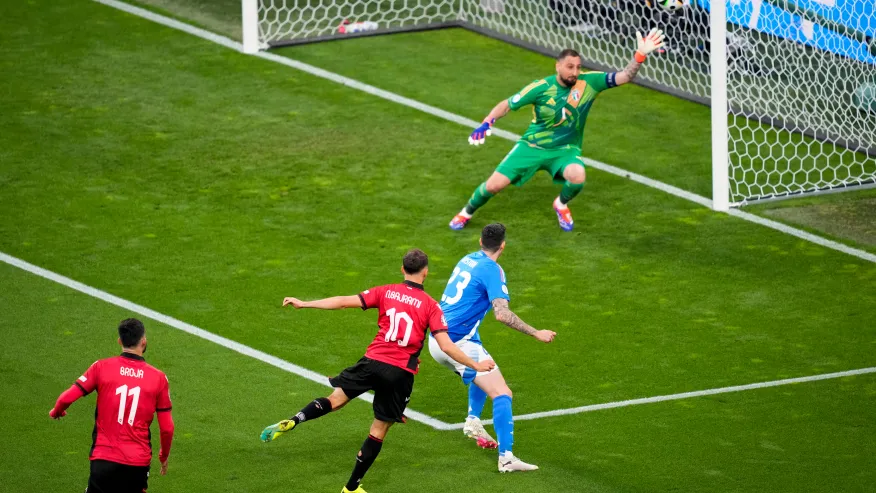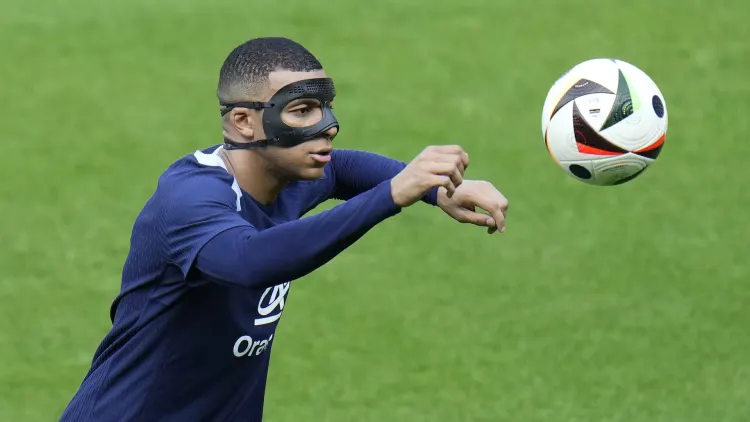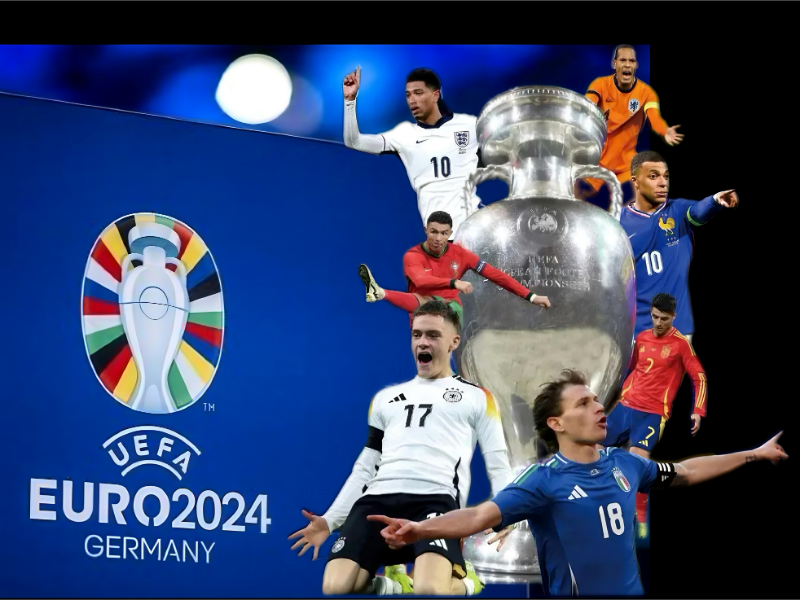- VAR and player tracking revolutionise fairness and strategy.
- Wearable tech and data analytics enhance performance and injury prevention.
Imagine watching the European Championship final, tension palpable, as a crucial goal is scored in the final minutes. The stadium erupts in cheers and jeers, but wait – the referee signals for a VAR (Video Assistant Referee) review. The entire world holds its breath as the decision unfolds. Moments later, the goal is confirmed offside by a matter of centimetres. VAR, with its precise technology, ensures fairness, turning what could have been a controversial decision into a universally accepted outcome. This moment perfectly encapsulates the transformative power of technology in football. VAR, alongside other cutting-edge innovations, is revolutionising the way the game is played, officiated, and experienced by fans. These advancements are not only enhancing fairness but also providing deeper insights into player performance and strategy.
VAR and player tracking
During the 2024 European Championship, the match between Italy and Spain showcased the crucial role of VAR and player tracking technology. In the 75th minute, Italy scored a goal that was initially deemed valid. However, the VAR review revealed an offside by mere centimetres, leading to the goal being disallowed. This decision, though controversial, highlighted the precision and fairness that VAR brings to the game.

Player tracking technology was also prominently used in the match between England and Germany. By using GPS and advanced sensors, real-time data on player movements, speeds, and positions were collected. This data helped England’s coaching staff make informed decisions on substitutions and tactical adjustments, ultimately contributing to their strategic victory.
At UEFA EURO 2024, the implementation of semi-automated offside technology (SAOT) marked a significant advancement in football officiating. This cutting-edge system, which has already been utilized during the tournament, combines tracking cameras and sensors within the match ball to provide precise data on player positions and ball movements. When a potential offside occurs, the technology quickly alerts the video assistant referees (VAR), who then review the incident and relay the decision to the on-field referee. This innovation has reduced the time required for offside decisions and minimized human error, resulting in fairer and more transparent matches.
The use of semi-automated offside technology and connected ball technology will undoubtedly help in making quicker and more accurate decisions, reducing controversies and improving the flow of the game.
Gary Lineker, former footballer and pundit
The official match ball for UEFA EURO 2024 is designed with cutting-edge technology to enhance the functionality of VAR and player tracking systems. Equipped with advanced sensors, the ball provides precise real-time data on its position, speed, and trajectory. This data is crucial for VAR, as it ensures accurate decisions on whether the ball has crossed the goal line, aiding referees in making critical calls during the match. Additionally, the integration of this data with player tracking systems allows for detailed analysis of ball interactions, offering insights into player movements and ball control. The ball’s aerodynamic design, high-quality synthetic materials, and eco-friendly manufacturing processes further enhance its performance and sustainability, making it an essential element in modern football technology.
The integration of these advanced technologies marks a significant step forward in ensuring fair play and enhancing the overall experience for players, officials, and fans.
Aleksander Čeferin, UEFA President
Wearable tech and data analytics
Wearable technology played a pivotal role in the match between Belgium and Portugal. Belgian players wore GPS vests and heart rate monitors to track their vital statistics. This real-time data allowed the coaching staff to adjust training loads and strategies during the game, helping to prevent injuries and enhance performance. For instance, France’s Kylian Mbappe eyes the ball with a pair of device during a training session.

Data analytics were extensively used by the French team during their group stage match against Denmark. By analyzing vast amounts of data on their opponents’ tactics and individual player performances, France devised effective counter-strategies. This analytical approach enabled them to break down Denmark’s defense and secure a crucial win.
Also read: Wearable technology: How it makes for a smarter future
Pop Quiz
What technology did teams use during the 2024 European Championship to monitor players’ physical condition and adjust training loads in real-time?
A. VAR
B. Player tracking
C. Wearable tech
D. AI analysis
The correct answer is at the bottom of the article.
Evolving fan experience
One of the most significant impacts of technology on the European Championship is the enhanced fan experience. Advanced broadcasting techniques, such as ultra-high-definition (UHD) and 360-degree cameras, allow fans to enjoy matches from virtually any angle. Interactive platforms and apps provide real-time statistics, replays, and behind-the-scenes content, making fans feel more connected to the action.
Hisense, a global leader in electronics and appliances, has partnered with UEFA EURO 2024, continuing their collaboration to enhance the football experience for fans worldwide. This partnership highlights Hisense’s commitment to innovation and technology, integrating advanced viewing experiences and cutting-edge technologies to elevate the global football experience. Through this collaboration, Hisense aims to bring fans closer to the action with state-of-the-art displays, enhanced broadcasting technologies, and fan engagement initiatives, making the tournament more immersive and enjoyable.
Fans experienced unprecedented access to match data through apps that offered live stats, player heat maps, and even VR replays. This level of engagement made watching football more interactive and enjoyable, as fans could analyze the game like never before.
Sustainability and smart stadiums
Technology is also playing a crucial role in making football more sustainable. Smart stadiums, equipped with energy-efficient systems, advanced waste management, and crowd control technologies, are setting new standards for environmental responsibility. The 2024 European Championship showcased some of the world’s most advanced stadiums, designed to minimize environmental impact while maximizing fan comfort and safety.
For instance, the Munich Stadium featured a modular design that allowed parts of the stadium to be dismantled and repurposed after the tournament. This innovative approach not only reduced construction waste but also demonstrated a commitment to sustainability.
Also read: Future of sports broadcasting: Paris Olympics sets new standards
Player health and safety
Player health and safety are paramount in football, and technology is making significant strides in this area. Concussion protocols have been enhanced with the use of head impact sensors. These devices monitor the force and frequency of impacts, helping medical staff make informed decisions about a player’s condition and readiness to return to play.
Additionally, wearable technology tracks players’ hydration levels, sleep patterns, and stress markers, providing a comprehensive view of their well-being. This data-driven approach helps teams manage player workloads and reduce the risk of overtraining and injuries.
Youth development and grassroots football
Technology’s impact on football extends beyond the professional level to youth development and grassroots initiatives. Advanced coaching tools, such as video analysis software and online training platforms, are helping young players improve their skills and understanding of the game. Grassroots programs are using technology to scout talent, organize tournaments, and provide equal opportunities for aspiring footballers.
For example, the UEFA Talent Development Scheme utilizes data analytics to identify promising players from a young age, ensuring they receive the support and training needed to reach their full potential. This approach is helping to create a more inclusive and competitive environment for future generations of footballers.
Personal reflection
As someone who hasn’t always been deeply involved in football, the technological innovations showcased in the 2024 European Championship have truly captivated me. Watching the precise decisions made by VAR, ensuring fairness in crucial moments, made me realise how much technology can enhance the integrity of the game. Seeing a goal overturned because of a matter of centimeters, with the entire world holding its breath, was an emotional rollercoaster that left me in awe of the precision and fairness modern technology brings to the sport. It’s incredible how such tools can transform a game, making it more transparent and just for everyone involved.
Moreover, witnessing the impact of wearable tech and data analytics on player performance and safety has deepened my appreciation for the sport. Knowing that players’ health and well-being are being meticulously monitored and protected through advanced gadgets made me feel more connected and empathetic towards them. The integration of AI and VR into training regimens, helping teams refine their tactics and strategies, added a layer of excitement and admiration for the behind-the-scenes efforts that go into each match. This championship has shown me that football is not just a game; it’s a dynamic fusion of athleticism and cutting-edge technology, creating a more immersive and thrilling experience for fans and casual observers like myself.
The Correct answer is C. Wearable tech

